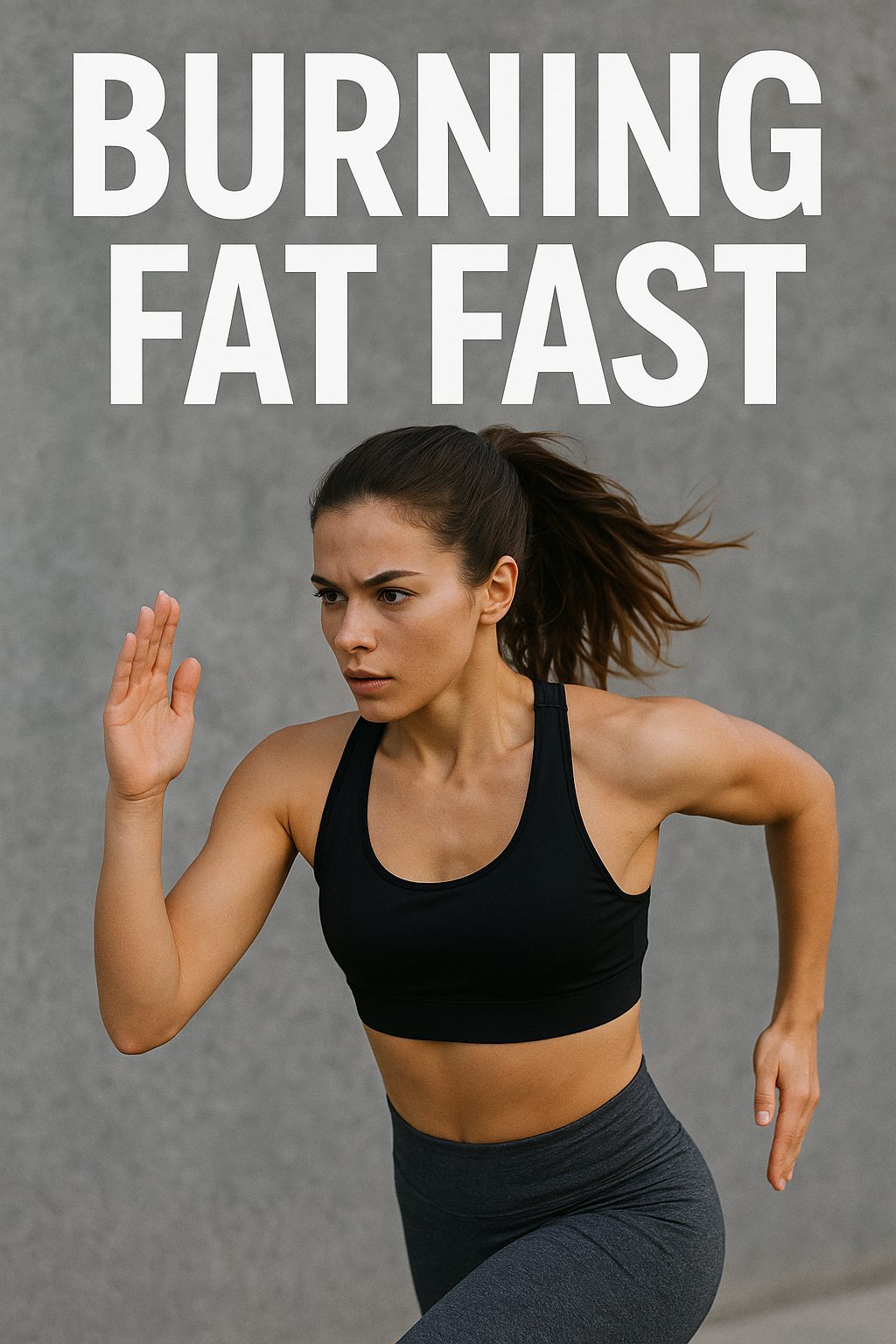Burning fat fast is not just about sweating more or eating less — it’s about making strategic, sustainable changes that reprogram your metabolism and target stored fat efficiently. The most frustrating part of fat loss is watching the scale move slowly despite your effort. If you’re eating “healthy” and exercising but still not seeing results, you’re likely missing key fat-burning levers that work with your body, not against it.

Fat loss is a metabolic process, not a punishment. And understanding how to trigger fat burning — without starving or obsessing — is the difference between temporary weight loss and long-term body recomposition. This article breaks down practical, evidence-based methods to help you burn fat fast, focusing on what truly works.
Here’s what you’ll discover:
-
How specific foods ignite your metabolism and encourage fat oxidation
-
Why macro balance matters more than calorie counting
-
Home workouts that spike your post-exercise fat burn
-
How sleep, hormones, and daily habits accelerate or sabotage fat loss
If you’re tired of extreme diets and want real, measurable change, start by fixing what you eat. Let’s look at the foods that work for your body — not against it.

1. Eat to burn: fat-burning foods that actually work
Forget low-calorie salads. If you want to burn fat fast, your food choices must support metabolic activity. Some foods require more energy to digest, increase thermogenesis, or contain compounds that promote lipolysis (fat breakdown). These aren’t “miracle” foods — they work because of their nutrient profile and how your body responds to them.
Top fat-burning foods to include daily:
-
Green tea – Contains catechins, particularly EGCG, which enhance fat oxidation.
-
Drink 2–3 cups per day between meals.
-
-
Chili peppers – Rich in capsaicin, a thermogenic compound.
-
Add to meals to boost calorie burn post-eating.
-
-
Eggs – High-protein, nutrient-dense, and keep you full longer.
-
Eat for breakfast to reduce cravings later.
-
-
Greek yogurt (unsweetened) – Supports gut health and is rich in casein protein.
-
Great as an evening snack or post-workout recovery.
-
-
Salmon and sardines – Omega-3 fatty acids reduce inflammation and regulate fat metabolism.
-
2–3 servings per week recommended.
-
-
Apple cider vinegar – Can stabilize blood sugar and reduce appetite.
-
Mix 1 tbsp in water before high-carb meals.
-
-
Cruciferous vegetables (broccoli, kale, cabbage) – High in fiber and compounds that support estrogen balance (important for fat storage in women).
-
Include at least one serving daily.
-
Pro tip: Combine protein with thermogenic spices (like lean chicken + chili) to double the metabolic effect of your meals.
Best times to eat fat-burning foods:
-
Morning: Start your day with protein + green tea to kickstart metabolism
-
Pre-workout: Chili, black coffee, or a light protein source to enhance fat oxidation
-
Evening: Fermented foods like yogurt or kimchi support digestion and overnight fat regulation
2. Balance your macros, not your life

Macro balance is the foundation of healthy fat loss. Cutting out entire food groups (like carbs or fats) might lead to initial weight loss, but it’s often unsustainable and can backfire. Instead of chasing numbers, focus on optimizing your macronutrient ratio for energy, satiety, and fat metabolism.
Ideal fat-burning macro split:
-
Protein: 30–35% of daily intake
-
Fats: 25–30% (focus on unsaturated and omega-3 fats)
-
Carbohydrates: 35–45%, mainly from whole foods and fiber-rich sources
This breakdown supports lean muscle retention, hormone balance, and metabolic flexibility — all crucial for long-term fat burning.
Why this matters:
-
Protein increases the thermic effect of food (up to 30% of protein calories are burned during digestion).
-
Healthy fats regulate hormones like leptin and insulin that control hunger and fat storage.
-
Fiber-rich carbs keep you full, reduce fat storage, and support gut health — a key player in weight regulation.
Simple steps to rebalance your macros:
-
Prioritize protein at every meal.
-
Aim for 1.5–2g per kg of body weight per day.
-
-
Don’t fear fats.
-
Include avocado, olive oil, flaxseeds, and fatty fish regularly.
-
-
Choose carbs that come with fiber.
-
Think lentils, oats, quinoa, sweet potatoes, berries.
-
Quick test: After eating, you should feel energized and satisfied — not sleepy or craving sugar. If you’re crashing, your macros may be off.
Next, we’ll look at how to turn your body into a fat-burning machine with efficient home workouts that don’t require hours at the gym.
3. Home workouts that torch calories

You don’t need a gym membership or hours of cardio to burn fat fast. The key is training smarter — not longer — by activating your full body, spiking your heart rate, and building lean muscle. These elements keep your metabolism elevated long after your workout ends, a phenomenon known as EPOC (excess post-exercise oxygen consumption), or the “afterburn effect.”
Why traditional cardio isn’t enough
Steady-state cardio burns calories during the workout — but that’s it. It doesn’t build muscle or significantly impact resting metabolism. In contrast, short, intense workouts that combine strength and speed stimulate fat loss even while you rest.
Try this 20-minute home fat-burning circuit (no equipment)
Do 3 rounds total. Rest 30 seconds between exercises and 1 minute between rounds.
-
Jump squats – 40 seconds
-
Push-ups – 30 seconds
-
High knees – 40 seconds
-
Glute bridges – 30 seconds
-
Mountain climbers – 40 seconds
-
Plank hold – 45 seconds
Do this 3–4 times per week for visible results in 2–3 weeks.
Weekly schedule for maximum results
| Day | Focus | Type |
|---|---|---|
| Monday | Full-body HIIT | Strength + Cardio |
| Tuesday | Active recovery | Walk, stretch, yoga |
| Wednesday | Lower body | Squats, lunges, glute work |
| Thursday | Rest | — |
| Friday | Upper body HIIT | Push-ups, rows, planks |
| Saturday | Core + mobility | Pilates, planks, twists |
| Sunday | Walk or stretch | Light movement |
FAQ:
Q: Can I do these workouts without prior fitness experience?
A: Yes. Start with shorter intervals (20–30 seconds) and modify moves (e.g., knee push-ups). Consistency matters more than intensity at first.
Q: What if I don’t lose weight despite regular workouts?
A: Focus on body composition. Fat loss doesn’t always show on the scale. Take waist measurements and photos weekly for real progress tracking.
4. Sleep more, stress less
Fat-burning doesn’t stop at the gym — it continues while you sleep. Poor sleep and chronic stress elevate cortisol, a hormone that not only increases belly fat but also slows metabolism and increases sugar cravings. Fixing your sleep and stress response is often the missing link in stubborn fat loss.
How stress sabotages fat burning
-
Increases cortisol, which stores fat in the abdominal area
-
Causes emotional eating and late-night snacking
-
Disrupts blood sugar balance and hunger hormones (ghrelin/leptin)
Practical ways to sleep deeper and stress less:
Evening routine (30–60 minutes before bed):
-
Shut down screens (blue light suppresses melatonin)
-
Take magnesium glycinate or drink herbal tea (chamomile, lemon balm)
-
Stretch or do gentle yoga
-
Try 4-7-8 breathing technique (inhale 4s, hold 7s, exhale 8s)
-
Go to bed and wake up at the same time every day — even weekends
Mini checklist: Better sleep for better fat loss
-
7–9 hours of uninterrupted sleep
-
Dark, cool room (18–20°C)
-
No caffeine after 2 PM
-
No large meals within 2 hours of bedtime
Tip: If you wake up tired or gain weight despite eating clean, sleep debt may be the reason.
5. Use your metabolism to your advantage
Your metabolism isn’t fixed. You can train it to work faster — and burn more fat — through specific habits that optimize your body’s natural energy systems.
What slows your metabolism:
-
Dieting too hard or too long
-
Skipping meals (especially breakfast)
-
Low muscle mass
-
Chronic sitting and low daily activity (low NEAT)
Smart ways to boost metabolism daily
-
Eat enough protein.
-
It takes more energy to digest protein, and it preserves muscle — your most metabolically active tissue.
-
-
Move more outside workouts.
-
NEAT (non-exercise activity thermogenesis) includes fidgeting, walking, cleaning — small movements that add up.
-
Aim for 7,000–10,000 steps/day.
-
-
Cold exposure.
-
Brief cold showers or cold air walks stimulate brown fat and increase calorie burn.
-
Start with 30 seconds and build up gradually.
-
-
Time your meals.
-
Front-load calories earlier in the day (larger breakfast, lighter dinner) to support insulin sensitivity and fat utilization.
-
-
Avoid metabolic slowdowns.
-
Refeed once a week with more carbs to reset leptin and thyroid hormones during long-term fat loss.
-
FAQ:
Q: Can skipping breakfast slow metabolism?
A: It depends. If your total calories and protein are sufficient, skipping breakfast (intermittent fasting) can work. But for some people, eating earlier helps reduce cravings and stabilize hormones.
Q: Is slow metabolism genetic?
A: Genetics play a role, but lifestyle has a greater impact. Sleep, stress, activity, and muscle mass are modifiable — and highly influential.
Next, we’ll explore the best supplements that support healthy fat loss without wasting your time or money.
6. Supplements that don’t waste your time
Supplements aren’t magic — but the right ones can support fat-burning processes when paired with solid nutrition and exercise. The key is to skip the hype and focus on compounds backed by actual human studies. Many over-the-counter “fat burners” are either underdosed, overstimulating, or full of ineffective fillers. You don’t need fancy formulas — you need targeted support.
What actually works (based on research):
-
Caffeine
-
Boosts metabolic rate and fat oxidation, especially before workouts
-
Dosage: 100–200 mg (1–2 cups of black coffee)
-
Timing: 30–45 minutes before training
-
-
Green tea extract (EGCG)
-
Enhances thermogenesis and fat breakdown
-
Works best when combined with caffeine
-
Dosage: 300–500 mg/day
-
-
L-carnitine
-
Helps transport fat into mitochondria to be burned as energy
-
Most effective in those with low carnitine levels or plant-based diets
-
Dosage: 1,000–2,000 mg/day
-
-
Protein powder
-
Supports lean muscle and increases thermic effect of food
-
Whey, casein, or plant-based options all work
-
Use as a meal addition or post-workout
-
Mini-table: Fat-burning supplements at a glance
| Supplement | Best time to take | Key benefit | Notes |
|---|---|---|---|
| Caffeine | Morning/pre-workout | Boosts energy & fat oxidation | Avoid late in day (sleep) |
| Green tea extract | With meals | Thermogenesis support | Look for decaffeinated option |
| L-carnitine | Before training | Enhances fat use as energy | Combine with carbs |
| Protein powder | Post-workout/meals | Muscle repair, fullness | 20–30g per serving |
⚠️ Avoid: DMAA, yohimbine (can cause heart issues), proprietary blends with unclear doses, and products promising “instant fat melt.”
FAQ:
Q: Do I need supplements to lose fat?
A: No. They’re optional tools. Focus on food, movement, and sleep first. Supplements should fill gaps, not replace good habits.
Q: Can I take multiple fat burners together?
A: Combining stimulants (like caffeine + green tea) is generally safe in moderate amounts. Avoid stacking multiple stimulants or exceeding 400 mg of caffeine/day.
7. Burn fat fast without extreme diets
Crash diets slow your metabolism, increase stress hormones, and often result in rebound weight gain. Instead, use smarter eating strategies that naturally reduce calories without triggering hunger, nutrient loss, or energy crashes.
Why extreme restriction fails:
-
Muscle loss = lower metabolism
-
Hormonal imbalance (thyroid, leptin, cortisol)
-
Binge eating and food obsession
-
Unsustainable long term
Smarter strategy: calorie cycling
Also called refeeding, this method alternates low- and high-calorie days to maintain metabolic health while still promoting fat loss.
How to do it:
-
5 low-calorie days (reduce 15–20% from maintenance)
-
2 higher-calorie days (return to maintenance or slightly above, focus on carbs)
This keeps leptin levels stable, supports thyroid function, and prevents metabolic adaptation — especially useful during long-term fat loss.
Intermittent fasting: does it work?
Yes, but only if it fits your lifestyle. Intermittent fasting helps some people reduce calorie intake naturally and improve insulin sensitivity, which aids in fat burning.
Popular methods:
-
16:8 – 16 hours fast, 8-hour eating window (e.g., 12 PM to 8 PM)
-
14:10 – gentler version, great for beginners
-
Alternate-day fasting – for advanced users with medical supervision
Choose the one that supports your energy, mood, and hunger levels. Fasting should reduce stress, not increase it.
What to eat on a fat-burning day:
-
Breakfast (if eating): protein smoothie with flax seeds + berries
-
Lunch: grilled salmon or tofu with quinoa and leafy greens
-
Snack: boiled egg, apple with almond butter
-
Dinner: stir-fry with lean meat/tempeh, veggies, and brown rice
Avoid ultra-processed foods even if they’re low in calories. Real food supports hormones, digestion, and long-term success.
FAQ:
Q: Can I lose fat without tracking calories?
A: Yes — by controlling portions, prioritizing protein, and cutting processed foods. But tracking for 1–2 weeks helps build awareness and may speed results.
Q: How much fat can I lose per week safely?
A: 0.5 to 1 kg (1–2 lbs) per week is realistic and sustainable. Faster loss may indicate water or muscle loss, not just fat.
8. Why slow and steady still wins (with a smarter edge)
It’s tempting to chase quick results, but the goal isn’t just losing weight — it’s keeping it off. Fast fat loss is possible when done correctly, but it requires strategy, patience, and consistency. Instead of extreme restriction, combine high-impact habits that support your metabolism, hormones, and mindset for long-term success.
9. Daily habits that support long-term fat loss
Fat loss is not just about what you do for an hour in the gym — it’s about how you live the other 23 hours. Small, consistent habits are what sustain your results, even after the scale stops moving. These behaviors improve metabolic health, regulate hunger, and reduce fat storage triggers like inflammation and insulin resistance.
Foundational daily habits:
-
Start your day with protein.
-
20–30g of protein in the morning stabilizes blood sugar, curbs cravings, and kickstarts metabolism.
-
Examples: protein shake, eggs with avocado, cottage cheese with berries.
-
-
Stay hydrated.
-
Water supports digestion, fat metabolism, and appetite regulation.
-
Tip: Drink 500ml water upon waking. Aim for 2–3L per day depending on activity.
-
-
Prioritize walking.
-
Low-intensity movement keeps metabolism elevated.
-
Set a timer to walk for 3–5 minutes every hour during sedentary tasks.
-
Bonus: Improves lymphatic drainage and reduces bloating.
-
-
Front-load your calories.
-
Eat more earlier in the day, less at night.
-
Helps balance insulin and circadian rhythms for better fat use.
-
-
Limit liquid calories.
-
Cut sugary drinks, alcohol, excessive creamers, and “healthy” smoothies loaded with sugar.
-
Replace with green tea, black coffee, water with lemon or cucumber.
-
-
Sleep before midnight.
-
Melatonin and growth hormone (fat-burning hormones) peak early in the night.
-
Sleep after 11 PM reduces their effectiveness.
-
These habits may seem small, but over weeks and months, they shape your body’s hormonal environment and make fat loss feel effortless.
10. Mistakes to avoid when trying to burn fat fast
Progress isn’t just about doing more — it’s also about avoiding what doesn’t work. Many people unknowingly sabotage their fat loss by chasing trends, overtraining, or ignoring key recovery factors.
Most common fat loss mistakes:
-
Over-restricting calories:
Leads to muscle loss, hormonal disruption, and binge cycles. -
Excessive cardio without strength training:
Cardio alone burns calories but does little for muscle or long-term metabolic health. -
Inconsistent routines:
Fat loss requires rhythm. Skipping workouts or yo-yo dieting confuses your body. -
Ignoring sleep and stress:
No amount of clean eating can compensate for chronic sleep debt or cortisol elevation. -
Obsessing over the scale:
Weight fluctuates. Track progress through how clothes fit, strength gains, waist circumference, and photos. -
Trying every new diet:
Keto, paleo, intermittent fasting — they all work when consistent. The problem isn’t the method; it’s the lack of adherence.
Focus on sustainability over perfection. Doing 80% of the right things consistently is far more effective than chasing 100% for a week, then quitting.
11. Putting it all together: a practical fat-burning lifestyle
The fastest way to burn fat isn’t about extremes — it’s about aligning daily actions with your body’s biology. When you build habits that respect sleep, movement, stress, and nutrition, fat loss becomes not only possible but maintainable.

Practical weekly checklist:
-
3–4 high-intensity workouts or strength training sessions
-
Daily walk (7,000–10,000 steps)
-
7–9 hours of quality sleep
-
High-protein meals (at least 1.6g/kg body weight)
-
Hydration: 2–3L of water
-
Limit sugar, refined carbs, alcohol
-
Regular meal timing (avoid late-night eating)
-
Stress reduction (breathing, journaling, nature exposure)
Sample day for fat-burning success:
-
7:00 AM – Wake, drink water, light stretching
-
7:30 AM – Protein-rich breakfast (e.g., eggs + greens + oats)
-
10:00 AM – Walk or move briefly
-
12:00 PM – Balanced lunch (lean protein + complex carbs + veggies)
-
3:00 PM – Snack (Greek yogurt, handful of almonds)
-
6:00 PM – Strength workout or short HIIT
-
7:00 PM – Light dinner (grilled tofu/salmon + salad)
-
9:00 PM – Screen-free wind-down, herbal tea
-
10:00 PM – Sleep
Final thoughts
Burning fat fast is possible — but only when done in a way that works with your body, not against it. There’s no one-size-fits-all secret. The most effective approach combines simple meals, consistent movement, smart rest, and realistic goals.
Instead of focusing solely on weight loss, focus on building energy, strength, and confidence. These internal wins naturally lead to external transformation. When you prioritize habits over hype, fat loss becomes a byproduct — not a punishment.















